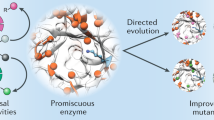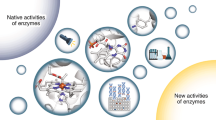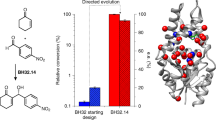Abstract
Biocatalysis has emerged as a powerful alternative to traditional chemistry, especially for asymmetric synthesis. One key requirement during process development is the discovery of a biocatalyst with an appropriate enantiopreference and enantioselectivity, which can be achieved, for instance, by protein engineering or screening of metagenome libraries. We have developed an in silico strategy for a sequence-based prediction of substrate specificity and enantiopreference. First, we used rational protein design to predict key amino acid substitutions that indicate the desired activity. Then, we searched protein databases for proteins already carrying these mutations instead of constructing the corresponding mutants in the laboratory. This methodology exploits the fact that naturally evolved proteins have undergone selection over millions of years, which has resulted in highly optimized catalysts. Using this in silico approach, we have discovered 17 (R)-selective amine transaminases, which catalyzed the synthesis of several (R)-amines with excellent optical purity up to >99% enantiomeric excess.
This is a preview of subscription content, access via your institution
Access options
Subscribe to this journal
Receive 12 print issues and online access
$259.00 per year
only $21.58 per issue
Buy this article
- Purchase on Springer Link
- Instant access to full article PDF
Prices may be subject to local taxes which are calculated during checkout



Similar content being viewed by others
References
Bornscheuer, U.T. & Kazlauskas, R.J. Hydrolases in Organic Synthesis (Wiley-VCH, Weinheim, Germany, 2005).
Breuer, M. et al. Industrial methods for the production of optically active intermediates. Angew. Chem. Int. Edn Engl. 43, 788–824 (2004).
Buchholz, K., Kasche, V. & Bornscheuer, U.T. Biocatalysis and Enzyme Technology (Wiley-VCH, Weinheim, Germany, 2005).
Schmid, A. et al. Industrial biocatalysis today and tomorrow. Nature 409, 258–268 (2001).
Schoemaker, H.E., Mink, D. & Wubbolts, M.G. Dispelling the myths—Biocatalysis in industrial synthesis. Science 299, 1694–1697 (2003).
Bommarius, A.S. & Riebel, B.R. Biocatalysis: Fundamentals and Applications (Wiley-VCH, Weinheim, Germany, 2004).
Grunwald, P. Biocatalysis: Biochemical Fundamentals and Applications (Imperial College Press, 2009).
Liese, A., Seelbach, K. & Wandrey, C. (eds.) Industrial Biotransformations (Wiley-VCH, Weinheim, London, UK, 2006).
Patel, R.N. (ed.) Biocatalysis in the Pharmaceutical and Biotechnology Industries (CRC Press, Boca Raton, Florida, USA, 2006).
Pollard, D.J. & Woodley, J.M. Biocatalysis for pharmaceutical intermediates: the future is now. Trends Biotechnol. 25, 66–73 (2007).
Straathof, A.J.J., Panke, S. & Schmid, A. The production of fine chemicals by biotransformations. Curr. Opin. Biotechnol. 13, 548–556 (2002).
Tao, J., Lin, G.-Q. & Liese, A. (eds.) Biocatalysis for the Pharmaceutical Industry: Discovery, Development, and Manufacturing (Wiley-VCH, Weinheim, Germany, 2009).
Hou, C.T. (ed.). Handbook of Industrial Biocatalysis (CRC Press, Boca Raton, Florida, USA, 2005).
Faber, K. Biotransformations in Organic Chemistry (Springer-Verlag, Berlin, 2004).
Mugford, P.F., Wagner, U.G., Jiang, Y., Faber, K. & Kazlauskas, R.J. Enantiocomplementary enzymes: classification, molecular basis for their enantiopreference, and prospects for mirror-image biotransformations. Angew. Chem. Int. Edn Engl. 47, 8782–8793 (2008).
Griengl, H., Schwab, H. & Fechter, M. The synthesis of chiral cyanohydrins by oxynitrilases. Trends Biotechnol. 18, 252–256 (2000).
Cheon, Y.-H. et al. Crystal structure of D-hydantoinase from Bacillus stearothermophilus: insight into the stereochemistry of enantioselectivity. Biochemistry 41, 9410–9417 (2002).
Gröger, H. et al. Enantioselective reduction of ketones with designer cells at high substrate concentrations: highly efficient access to functionalized optically active alcohols. Angew. Chem. Int. Edn Engl. 45, 5677–5681 (2006).
Fox, R.J. et al. Improving catalytic function by ProSAR-driven enzyme evolution. Nat. Biotechnol. 25, 338–344 (2007).
Kazlauskas, R.J. & Bornscheuer, U.T. Finding better protein engineering strategies. Nat. Chem. Biol. 5, 526–529 (2009).
Lutz, S. & Bornscheuer, U.T. (eds.) Protein Engineering Handbook (Wiley VCH, Weinheim, Germany, 2009).
Turner, N.J. Directed evolution drives the next generation of biocatalysts. Nat. Chem. Biol. 5, 567–573 (2009).
Reetz, M.T., Carballeira, J.D. & Vogel, A. Iterative saturation mutagenesis on the basis of B factors as a strategy for increasing protein thermostability. Angew. Chem. Int. Edn Engl. 45, 7745–7751 (2006).
Ivancic, M., Valinger, G., Gruber, K. & Schwab, H. Inverting enantioselectivity of Burkholderia gladioli esterase EstB by directed and designed evolution. J. Biotechnol. 129, 109–122 (2007).
Koga, Y., Kato, K., Nakano, H. & Yamane, T. Inverting enantioselectivity of Burkholderia cepacia KWI-56 lipase by combinatorial mutation and high-throughput screening using single-molecule PCR and in vitro expression. J. Mol. Biol. 331, 585–592 (2003).
Magnusson, A.O., Takwa, M., Hamberg, A. & Hult, K. An S-selective lipase was created by rational redesign and the enantioselectivity increased with temperature. Angew. Chem. Int. Edn Engl. 44, 4582–4585 (2005).
May, O., Nguyen, P.T. & Arnold, F.H. Inverting enantioselectivity by directed evolution of hydantoinase for improved production of l-methionine. Nat. Biotechnol. 18, 317–320 (2000).
Williams, G.J., Woodhall, T., Farnsworth, L.M., Nelson, A. & Berry, A. Creation of a pair of stereochemically complementary biocatalysts. J. Am. Chem. Soc. 128, 16238–16247 (2006).
Zha, D.X., Wilensek, S., Hermes, M., Jaeger, K.E. & Reetz, M.T. Complete reversal of enantioselectivity of an enzyme-catalyzed reaction by directed evolution. Chem. Commun. (Camb.) 2664–2665 (2001).
Bartsch, S., Kourist, R. & Bornscheuer, U.T. Complete inversion of enantioselectivity towards acetylated tertiary alcohols by a double mutant of a Bacillus subtilis esterase. Angew. Chem. Int. Edn Engl. 47, 1508–1511 (2008).
Iwasaki, A., Yamada, Y., Ikenaka, Y. & Hasegawa, J. Microbial synthesis of (R)- and (S)-3,4-dimethoxyamphetamines through stereoselective transamination. Biotechnol. Lett. 25, 1843–1846 (2003).
Matcham, G.W. & Bowen, A.R.S. Biocatalysis for chiral intermediates: Meeting commercial and technical challenges. Chim. Oggi 14, 20–24 (1996).
Koszelewski, D., Lavandera, I., Clay, D., Rozzell, D. & Kroutil, W. Asymmetric synthesis of optically pure pharmacologically relevant amines employing ω-transaminases. Adv. Synth. Catal. 350, 2761–2766 (2008).
Savile, C.K. et al. Biocatalytic asymmetric synthesis of chiral amines from ketones applied to sitagliptin manufacture. Science 329, 305–309 (2010).
Jansonius, J.N. Structure, evolution and action of vitamin B6-dependent enzymes. Curr. Opin. Struct. Biol. 8, 759–769 (1998).
Percudani, R. & Peracchi, A. The B6 database: a tool for the description and classification of vitamin B6-dependent enzymatic activities and of the corresponding protein families. BMC Bioinformatics 10, 273 (2009).
Höhne, M. & Bornscheuer, U.T. Biocatalytic routes to optically active amines. ChemCatChem 1, 42–51 (2009).
Cahn, R.S., Ingold, C. & Prelog, V. Specification of molecular chirality. Angew. Chem. Int. Edn Engl. 5, 385–415 (1966).
Mizuguchi, H. et al. Strain is more important than electrostatic interaction in controlling the pK(a) of the catalytic group in aspartate aminotransferase. Biochemistry 40, 353–360 (2001).
Okamoto, A., Nakai, Y., Hayashi, H., Hirotsu, K. & Kagamiyama, H. Crystal structures of Paracoccus denitrificans aromatic amino acid aminotransferase: A substrate recognition site constructed by rearrangement of hydrogen bond network. J. Mol. Biol. 280, 443–461 (1998).
Sugio, S., Petsko, G.A., Manning, J.M., Soda, K. & Ringe, D. Crystal structure of a D-amino acid aminotransferase: how the protein controls stereoselectivity. Biochemistry 34, 9661–9669 (1995).
Goto, M., Miyahara, I., Hayashi, H., Kagamiyama, H. & Hirotsu, K. Crystal structures of branched-chain amino acid aminotransferase complexed with glutamate and glutarate: true reaction intermediate and double substrate recognition of the enzyme. Biochemistry 42, 3725–3733 (2003).
Mehta, P.K., Hale, T.I. & Christen, P. Aminotransferases: demonstration of homology and division into evolutionary subgroups. Eur. J. Biochem. 214, 549–561 (1993).
Wolf, Y., Madej, T., Babenko, V., Shoemaker, B. & Panchenko, A.R. Long-term trends in evolution of indels in protein sequences. BMC Evol. Biol. 7, 19 (2007).
Hanson, R.L. et al. Preparation of (R)-amines from racemic amines with an (S)-amine transaminase from Bacillus megaterium. Adv. Synth. Catal. 350, 1367–1375 (2008).
Shin, J.-S., Yun, H., Jang, J.-W., Park, I. & Kim, B.-G. Purification, characterization, and molecular cloning of a novel amine:pyruvate transaminase from Vibrio fluvialis JS17. Appl. Microbiol. Biotechnol. 61, 463–471 (2003).
Schätzle, S., Höhne, M., Redestad, E., Robins, K. & Bornscheuer, U.T. Rapid and sensitive kinetic assay for characterization of ω-transaminases. Anal. Chem. 81, 8244–8248 (2009).
Schätzle, S., Höhne, M., Robins, K. & Bornscheuer, U.T. A conductometric method for the rapid characterization of the substrate specificity of amine-transaminases. Anal. Chem. 82, 2082–2086 (2010).
Höhne, M., Kühl, S., Robins, K. & Bornscheuer, U.T. Efficient asymmetric synthesis of chiral amines by combining transaminase and pyruvate decarboxylase. ChemBioChem 9, 363–365 (2008).
Author information
Authors and Affiliations
Contributions
K.R. and U.T.B. initiated the project. M.H. designed the in silico strategy, devised the annotation algorithm and performed the database search and identification of the putative amine transaminases. M.H. expressed and confirmed amine transaminase activity and (R)-selectivity for the first three proteins. S.S. coordinated the comparative characterization of all proteins and performed cloning, expression, purification, data collection and data analysis. H.J. contributed to gene cloning, protein expression and activity measurements. U.T.B. and M.H. cowrote the paper, and all authors read and edited the manuscript.
Corresponding author
Ethics declarations
Competing interests
Karen Robins is an employee of Lonza AG, which sponsored the research at Greifswald University.
Supplementary information
Supplementary Text and Figures
Supplementary Results, Supplementary Figures 1–7 and Supplementary Tables 1–5 (PDF 4808 kb)
Rights and permissions
About this article
Cite this article
Höhne, M., Schätzle, S., Jochens, H. et al. Rational assignment of key motifs for function guides in silico enzyme identification. Nat Chem Biol 6, 807–813 (2010). https://doi.org/10.1038/nchembio.447
Received:
Accepted:
Published:
Issue Date:
DOI: https://doi.org/10.1038/nchembio.447
This article is cited by
-
Reprogramming biocatalytic futile cycles through computational engineering of stereochemical promiscuity to create an amine racemase
Nature Communications (2024)
-
A growth selection system for the directed evolution of amine-forming or converting enzymes
Nature Communications (2022)
-
Characterization of proteins from the 3N5M family reveals an operationally stable amine transaminase
Applied Microbiology and Biotechnology (2022)
-
In silico screening and heterologous expression of soluble dimethyl sulfide monooxygenases of microbial origin in Escherichia coli
Applied Microbiology and Biotechnology (2022)
-
Redesign of (R)-Omega-Transaminase and Its Application for Synthesizing Amino Acids with Bulky Side Chain
Applied Biochemistry and Biotechnology (2021)



